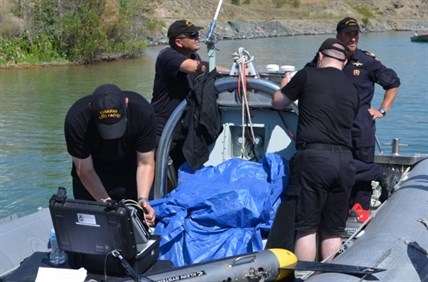
Tyler Newman says dealing with UXOs in the water is more complicated than retrieving them on land.
(CHARLOTTE HELSTON / iNFOnews.ca)
August 11, 2013 - 12:50 PM
VERNON - It was a pretty rare occurrence for the Pacific military dive team to take a dip in Kalamalka Lake this week.
The ordnance team from Colwood, B.C. was called out to Vernon after a swimmer discovered a strange object lying in the sand 20 feet under water, about 100 feet offshore from Cosens Bay. The object turned out to be a military mortar, or unexploded ordnance, left behind from training practices during the Second World War. Lt. Mike St.-Pierre says it was difficult to find it.
"It was like a needle in a haystack," St.-Pierre says.
The search was narrowed down a bit by the swimmer who first discovered the mortar while free diving in the area. Still, St.-Pierre says it took hours to locate it using X-ray equipment that can see through sand and pick up on objects of interest.
"Eventually one of our guys found it on the fourth or fifth circle," he says.
It was 2 a.m. when they found it, and for safety reasons, St.-Pierre says they returned to remove it early the following morning, when the lake wasn't busy with other boaters. A line was attached to the mortar and tugged to test if it would fire. When it didn't, they pulled it up, put it in a kevlar bag, and took it to the military range where they destroyed it.
"It's no longer a hazard," St.-Pierre says, adding the team will continue to sweep the area looking for other left over military equipment, possibly for the next few days.
The ordnance team says the majority of their work is done on land, partly because there's far less of a chance someone will come into contact with an ordnance in the water. For the most part, the sea bottom is undisturbed by human contact, with objects remaining unknown to the world until someone happens to stumble upon them.
"It's amazing that (the swimmer) found it," St.-Pierre says. "We really should recruit him."
The team says water missions are much harder, because divers have to deal with currents, the added awkwardness of scuba gear, altered depth perception and water visibility. The crystal clear waters of Kalamalka lake were a welcome asset in the search, they say.
Tyler Newman, explosive ordnance disposal operator, says working with unexploded ordnances in the water is a rare challenge.
"Things aren't getting turned around as much in the water," he says. "They might have been there for 70 or 80 years. It's easy for them to get hidden."
RCMP and the ordnance team say this is the only time one was found in Kalamalka Lake in recent memory.
If you think you've found an ordnance, either on land or in the water, immediately report it to police. Eight people lost their lives in the Vernon area, including two boy scouts in the 1960s, from the leftover bombs.
To contact the reporter for this story, email Charlotte Helston at chelston@infotelnews.ca, call (250)309-5230 or tweet @charhelston.

Divers from the Pacific Fleet Diving Unit preparing to head out for another sweep of Kalamalka lake.
(CHARLOTTE HELSTON / iNFOnews.ca)

Lt. Mike St.-Pierre says finding the mortar was like looking for a needle in a haystack.
(CHARLOTTE HELSTON / iNFOnews.ca)
News from © iNFOnews, 2013